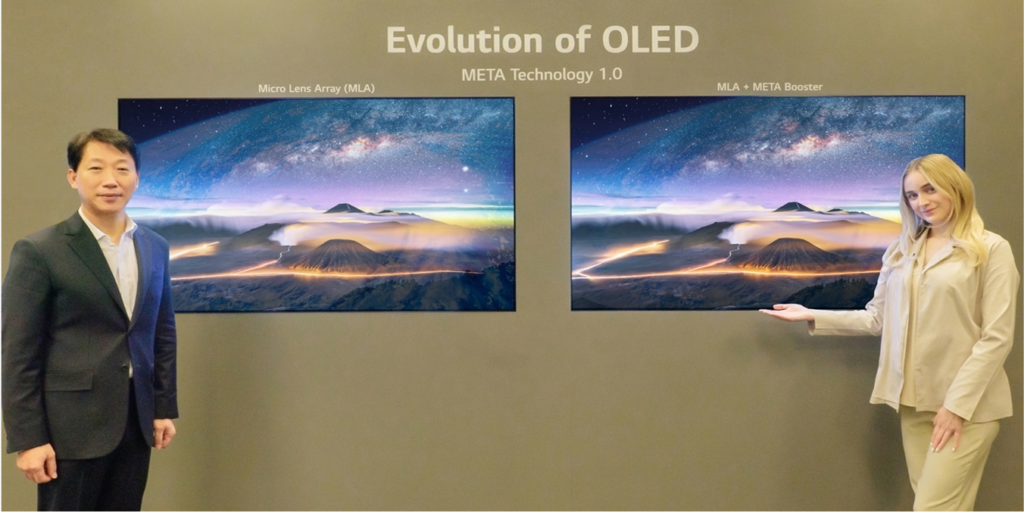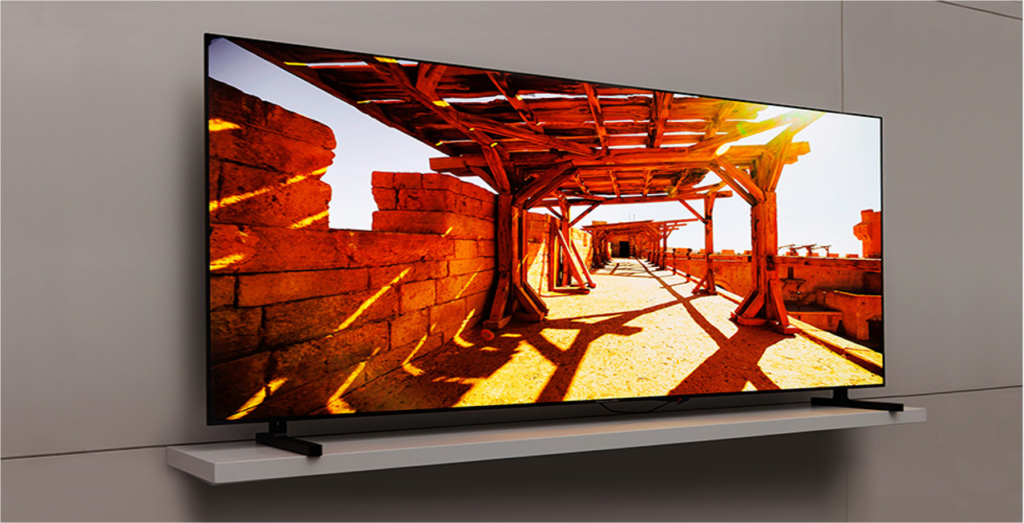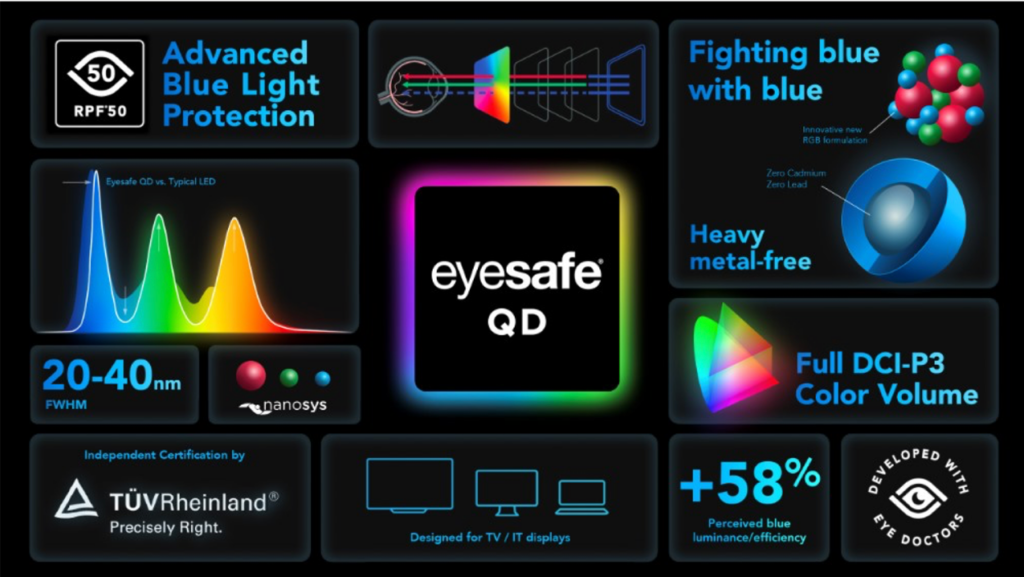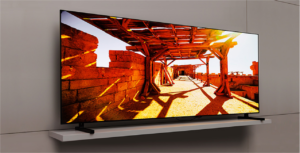Suppliers showcased their NextGen display products at CES giving a glimpse of what to expect in 2023 and beyond. Technology innovations on display panel drive product innovations in the consumer TV market. This year, display suppliers such as LG Display, Samsung Display, TCL China Star and others showcased ranges of technology developments for TV display panel. Technology innovations are very important for the growth of TV market specially in a slow demand growth environment.
White OLED TV: Increasing Brightness with Micro Lens Array
OLED TV from LG Electronics with LG Display panels dazzled CES this year with hundreds of white OLED 55-inch TV display. LGE showed products with enhanced features, performance and sizes reaching 97-inch. LG Display unveiled their third generation OLED TV display technology based on “META Technology” at CES. META Technology comprises a ‘Micro Lens Array’ that maximizes light emission from the OLED panel and ‘META Booster,’ a brightness-enhancing algorithm. According to LGD based on META technology, their latest OLED displays can achieve 60% brighter images and 30% wider viewing angles than conventional OLED displays. It can also achieve improved energy efficiency. Using Meta technology TV can have 2100nits peak brightness. Last year LGD introduced its deuterium technology and personalized algorithms to enhance brightness by up to 30% compared to previous generation products.
META technology maximizes light emission from the OLED panel and enhances energy efficiency by 22 percent compared to that of the same brightness. META Booster, improves both screen brightness and color expression by analyzing and adjusting the brightness of each scene in real time. This also enhances HDR (High Dynamic Range). Meta also helps to deliver wide viewing angle of 160 degrees which can deliver pictures at any angle without image distortion. LGD plans to apply Meta technology to its 55”, 65”, 77” 4K and 77”, 88” 8K OLED TV panels with the strategy of focusing on ultra-premium TV market. LG display is the sole supplier of white OLED TV panels. White OLED TVs are sold under several brands including LG Electronics, Sony, and others. WOLED TV has experienced strong growth path and gained dominance in the premium market. The technology is still evolving and capacity is expanding helping it to gain higher market shares.

QD (Quantum Dot) OLED TV: Increasing Performance with New EL Material
QD OLED, display technology was introduced at CES last year by Samsung Display. It dazzled audiences with superior display performance and received great reviews. The company introduced QD-Display for the home entertainment market in two TV sizes, 55” and 65”, along with a 34” curved gaming monitor. The display integrated printed Quantum Dots with blue self-emitting pixels. QD Display can provide superior color performance as it does not rely on color filters like WOLED or LCD. This year Samsung Display unveiled QD OLED 2023 with addition of 77” TV and 49” ultra-wide monitor. The 2023 lineup products used advanced optimization algorithm InteliSense AI and new OLED HyperEfficient EL material improving color brightness of each RGB according to the company information. As a result, maximum brightness of combined RGB color brightness achieved more than 2000 nits. Image quality and panel efficiency has been greatly increased with advanced AI technology.
According to the company QD OLED 2023 has reduced power consumption of 2022 models up to 25% by applying high efficiency organic materials and more advanced AI technology. Samsung Display is the only supplier for QD OLED display panel. Further investment in QD OLED technology to increase capacity is expected in 2023. Sony and Samsung Electronics are already selling 55” and 65” QD OLED TVs from last year. Samsung followed some aggressive pricing strategy towards the end of 2022, especially for black Friday that resulted in higher sales. More suppliers including TCL are planning to join in which will result in higher shares for QD OLED TV in 2023.

IJP (Ink Jet Printing) OLED TV: Prototype was Unveiled at CES
TCL CSOT unveiled their 65-inch 8K IJP-OLED display, the world’s first 65” 8K printed OLED. It is jointly developed by TCL CSOT and JOLED. The new 8K product with up to 33 million ultra-high pixels has highest resolutions and refresh rates developed by an ink jet printing OLED technology. It boasts an improved refresh rate, higher brightness and a narrower border compared to previous model according to company information. IJP for RGB OLED printing has been challenging due to material issues and manufacturing complexities as it needs OLED materials compatible with solution printing. New generations of products are leading to performance improvements. A technology showcase prototypes will take longer time before it can be commercialized.
MiniLED QD LCD TV: Increasing in Size and Performance
TCL won two innovation awards at CES 2023 for their MiniLED 4K TVs. The company has been a pioneer for MiniLED TV. According to the company its 75”4K TV combines miniLED and QLED technologies to deliver optics up to 1920 Full array Local dimming zones in 4K resolution, true to life colors and 144Hz variable refresh rates (VRR). Last year TCL also won CES award for its QD zero MiniLED 8K TV that had an ultrathin profile of less than 3.4 mm. The company also showed their 98” TV based miniLED and QD technology at CES this year. Samsung showcased its new Neo QLED TV in 4K and 8K resolutions based on Quantum Dot and MiniLED backlight technology. According to the company its Neo QLED picture quality is powered by Samsung’s advanced neural quantum processor which supports the quantum miniLED lit TV with 14bit processing power and AI upscaling. It also uses AI deep learning technology to analyze and apply real-time HDR to give more immersive experience. Sharp made global debut of their AQUOS XLED TV at CES this year that combines miniLED and QD technology.
More brands have adopted miniLED and QD TV technologies for their product offerings. Cost is still a challenge for miniLED TV. LED costs are coming down. Suppliers are also increasing more dimming zones per driver ICs, improving transfer throughputs and transfer yield rates and integrating supply chain to reduce costs and improve performance. Drastic panel price reduction for LCD in the first 3 quarters of 2022 will contribute to reduce costs for MiniLED based products in 2023. MiniLED QD TVs have increased shares and shipments with higher display performance, higher resolutions (4K and 8K), larger screen sizes (higher production from 10.5 Gen fabs)) and more product options in 2022 and expected to increase shares and shipments in 2023. It is still lagging OLED TV shipments.
MicroLED TV: Expanding to Smaller Sizes
Samsung introduced 2023 MicroLED lineup with new models ranging from 50” to 140” at CES. As the company presented; due to its modular nature MicroLED is not bound by shape, ratio, and size. It can be customized to fit a consumer’s desired setup. It also comes without bezels. MicorlED TVs have superior picture quality but prices have been extremely high for the consumer market.
Quantum Dot TV: Introducing Eyesafe Blue Quantum Dots
Quantum Dot display technology is continuously evolving with new materials and new processes. Most of the top TV manufacturers such as Samsung, LGE, Sony, TCL, Hisense, Vizio, and Skyworth have already adopted QD (QDEF) display technology in their TVs. It has enabled LCD technology to reinvent itself and has created growth opportunities in the TV market especially when combined with miniLED backlights. It has also empowered OLED with the introduction of QD OLED displays.
At CES 2023, Nanosys and Eyesafe, the leading blue light mitigation technology company jointly introduced Eyesafe QD. Eyesafe QD is a new type of QDEF quantum dot technology for LCD screens based on an all-new heavy metal free quantum dot developed by Nanosys. Each Eyesafe QD component contains trillions of quantum dots that absorb blue light from a standard LED, converting it into a perfectly optimized red, green and blue spectrum designed for human health without compromising color or efficiency performance. Eyesafe QD guarantees advanced blue light protection, with a minimum rating of RPF50. It delivers full DCI-P3 color volume and +58% increased perceived improvement in blue luminance. Eyesafe QD will be certified by TÜV Rheinland. Nanosys and Eyesafe will begin sampling Eyesafe QD to display makers in early 2023 for inclusion in 2024 products.

Innovation and technology developments in display materials and components will empower next generations TV. Universal Display, the leading OLED material company has announced recently that their development of commercial phosphorescent blue emissive system remains in schedule and they met their preliminary target specification in 2022. This should enable their introduction of all phosphorescent RGB stack into the commercial market in 2024. This can help next generation products for both white OLED and QD OLED TV as more efficient blue OLED will bring down cost and increase performance.
Next generation of TV displays are not only going to be better, bigger and brighter; they will also be safer for the eyes and the environment.
Sweta Dash is the founding president of Dash-Insights, a market research and consulting company specializing in the display industry. For more information, contact [email protected] or visit www.dash-insights.com.

